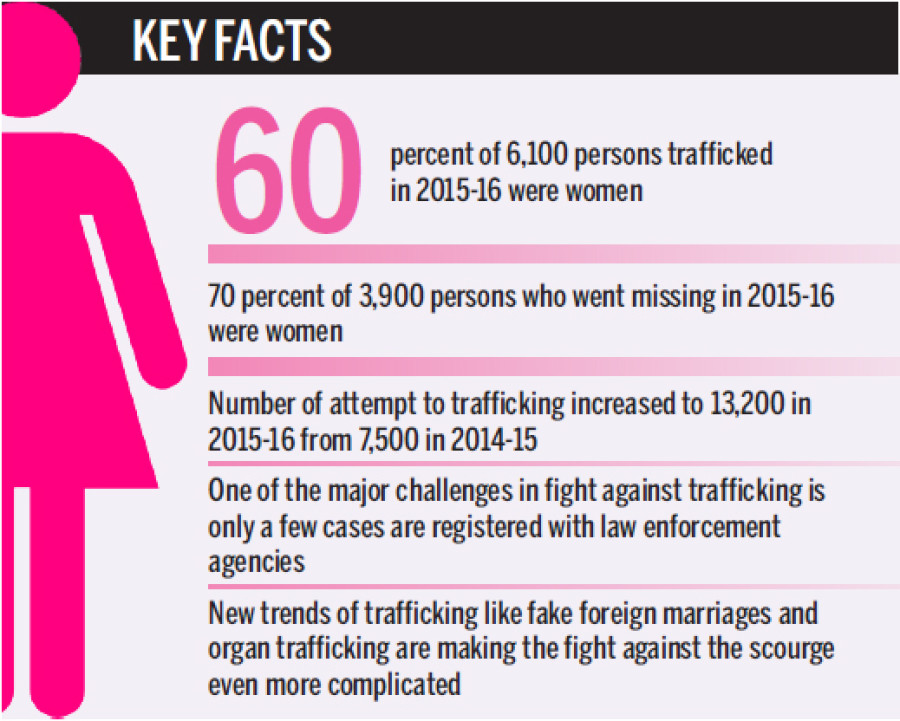Miscellaneous
Over 6,000 trafficked in 2015-16, says NHRC report
Over 6,000 Nepalis were trafficked while around 4,000 went missing in fiscal year 2015-16, with a majority of them being women, according to the latest report of the National Human Rights Commission.
Over 6,000 Nepalis were trafficked while around 4,000 went missing in fiscal year 2015-16, with a majority of them being women, according to the latest report of the National Human Rights Commission.
The report, “Trafficking in Person 2015-16”, a compilation of data received from Nepal Police and government and non-government organisations, paints a bleak picture of how people, particularly women and children, are still falling victim to human trafficking despite continuous efforts to stop the scourge.
According to the report, 60 percent of the 6,100 persons trafficked into different countries in fiscal year 2015-16 were women. Again, women accounted for 70 percent of 3,900 persons who went missing.
The report also says the emerging trends of human trafficking are a growing concern, as destination countries were found to be changing from India and other Gulf countries to China, South Korea and Afghanistan.
“The cases of trafficking in the name of marriage and ‘orchestra dancers’ is increasing in new destinations like China and South Korea,” Mohna Ansari, a member of the NHRC, told the media while releasing the report on Tuesday. “Forms and dynamics of trafficking have changed over the years,” added Ansari, pointing to how complicated the fight against the scourge has become.
Fake foreign marriages, assurances of the good employment and use of fake travel documents are among the new modus operandi of human traffickers. The report says trafficking of children for organ transplantation is also increasing.
Among the total missing in 2015-16 fiscal year, 1,502 were children.
Poverty, desire to go abroad and have a good life and better employment opportunities fuel human trafficking, according to the report.
While individual “agents” have long been involved in luring unsuspecting people, particularly women and children, into jobs and better life, recruiting agencies, education consultancies, marriage bureaus and cultural groups are also working as traffickers, the report says.
One of the major problems, according to the stakeholders, when it comes to fighting trafficking is only a few cases are registered with police.
A little over 200 cases were registered with police in the last fiscal year, according to the report. The number of victims the same year, however, stood at 352.
“Only a few cases are registered with police, and the number of convicts is even fewer,” said NHRC Chair Anup Raj Sharma, pointing to poor investigation.
Government officials say human traffickers often manage to make “extremely convincing” arguments to lure people.
Khaga Raj Baral, secretary at the Ministry of Women, Children and Social Welfare, said there are even cases in which some people were saved from being trafficked as many as four times.
“The counselling given to a victim would not work,” he said, adding: “Oftentimes even the rescuers have to take the blame just because they were trying to stop them from being trafficked.”
Poverty is one of the reasons fuelling trafficking, but he points at the “huge investment” some people make to enter the United States illegally. “Even educated people ‘are investing to get trafficked’,” he said.
Though the number of people trafficked in the fiscal year has decreased from that in 2014-15 by 2,000, cases of attempt to trafficking were higher. The number of attempt to trafficking increased to 13,200 in 2015-16 from 7,500 in 2014-15, according to the NHRC report.
Of the total trafficked individuals, people from Janajati community accounted for 48 percent followed by Brahmin/Chhetri (29 percent), Dalit (15 percent) and Madhesi (eight percent).




 8.12°C Kathmandu
8.12°C Kathmandu









